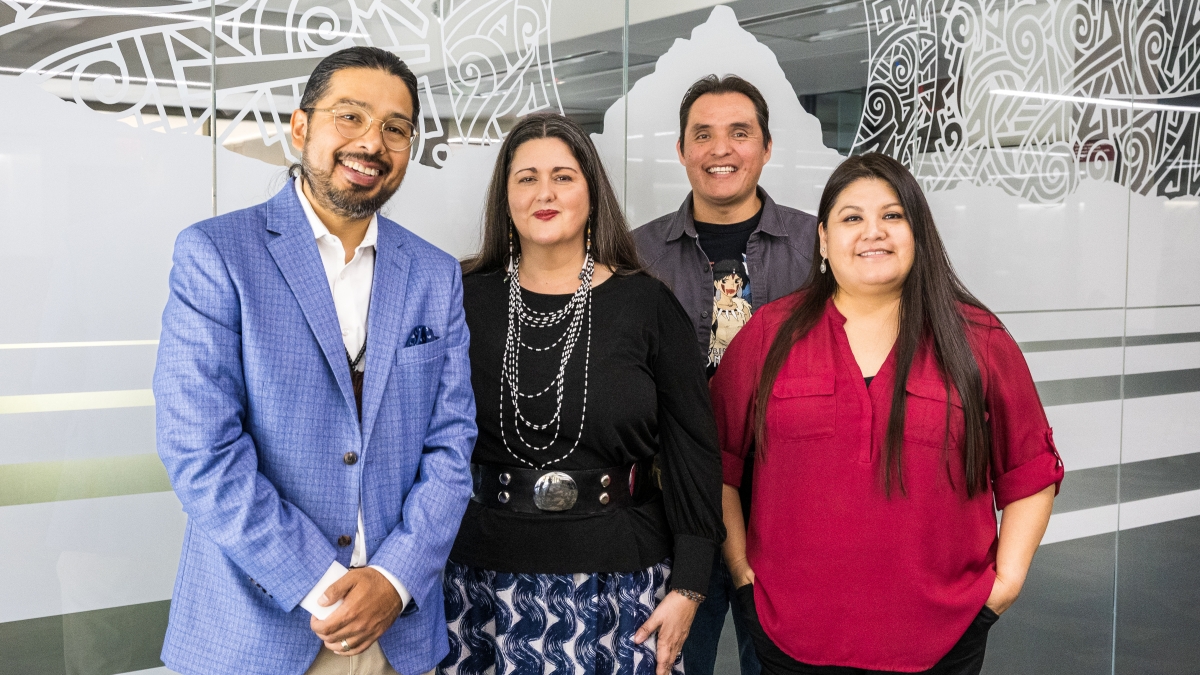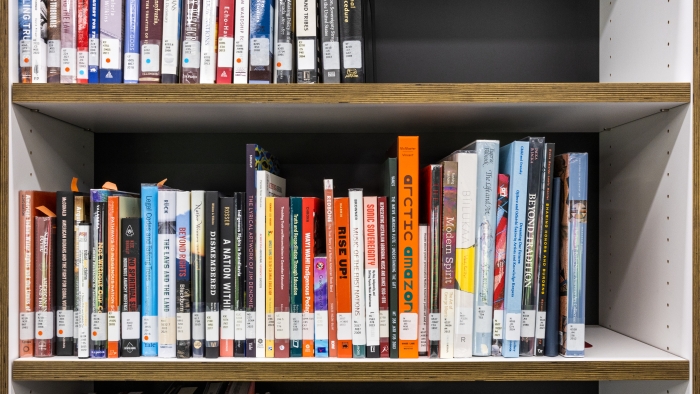
- Details
- By Scott Bordow for ASU News
Center will hold open house featuring tours, food and music on April 3
Alexander Soto’s excitement and joy was evident as he showed a visitor the new Labriola National American Indian Data Center space inside Hayden Library on Arizona State University’s Tempe campus.
There, said Soto, the center’s director, is the huge wall mural that represents O’odham land recently painted by Indigenous artists Thomas “Breeze” Marcus (Tohono O’odham) and Dwayne Manuel (Akimel O’odham).
[Note: This article was originally published in the ASU News. Used with permission. All rights reserved.]
The art on those glass walls that enclose the space? It depicts mountains sacred to the O’odham tribe, Soto said, and establishes the tone of what Labriola is doing because it centers the land, the community and the arts in a library setting.
Along that wall, Soto pointed out, are thousands of books by Indigenous authors, multiple quiet spaces to study or hang out and snacks for hungry college students.
There's also a multi-use area that can be used for book talks, workshops, even a live band, and includes a camera and speakers in the ceiling, a microphone and three monitors for Zoom calls or livestreaming events on social media.
Six thousand square feet in all, the culmination of Soto’s vision to transform the Labriola Center into an Indigenous knowledge zone for Native American students.
“Whether it’s President (Michael) Crow’s commitment to American Indian students or to show the history of Native people and where we are in 2024, library centers like this are needed to access Indigenous information,” Soto said.
“But it must be done in a way that’s going to help students understand where they fit in the solutions moving forward. It’s easy to gripe and point to the past, but this space has an opportunity to help our students see what is possible. With our staff members being all Indigenous, we can provide library services that support Indigenous research methodologies.
"This is a game changer since Native students don’t have to explain themselves to us since we can relate to where they are coming from.”
To inaugurate its new space, the Labriola Center will hold an open house from 3 p.m. to 6 p.m. on April 3. Tours will be provided, Labriola’s employees will be on hand to answer questions, visitors can dine on Indigenous food and the Indigenous indie rock band One Way Sky will perform that evening.
“We are excited to celebrate the opening of the Labriola National American Indian Data Center, a national model for Indigenous-led library services,” Crow said. “The center represents an important opportunity to advance quality data and collaboration that supports the success of Indigenous communities in Arizona and far beyond.”
The expanded space is just one aspect of Labriola’s growth the past year. The center has quadrupled its Indigenous staff, adding librarian Vina Begay and two program coordinators, Yitazaba-Largo Anderson and Eric Hardy.
The center also was awarded a $1 million grant from the Mellon Foundation for “Firekeepers: Building Archival Data Sovereignty Through Indigenous Memory Keeping.” The three-year project will allow the center to better support tribal nations that are seeking to establish archival collections. As part of that grant, Alycia de Mesa was hired as an Indigenous education specialist, and Penrose Fulwilder was hired as an O’odham Language specialist.
The growth of the team has been recognized with partnerships and events across ASU and tribal communities, such as hosting the Arizona Department of Education’s Office of Indian Education Symposiums in 2022 and 2023.
But at the heart of the center’s mission is its desire to connect with the approximately 3,800 Native American students on campus and the surrounding Native American community.
"The expansion of the Labriola Center demonstrates a commitment to serving the needs of ASU Native students and tribal nations and communities,” said Jacob Moore, vice president and special advisor to the president on American Indian Affairs. “Alex Soto and the entire Labriola Center team provide an extensive collection of research resources, archival services and state-of-the-art community space dedicated to amplifying Indigenous voices past, present and future.
"The expanded setting helps to assure our Native students that they belong here and is an integral part of fulfilling ASU's charter to address the needs of the communities it serves."
Hardy said he wants the center to be a “place of community” for Native American students, through not only its books and collections but with poetry and music. At the beginning of each semester, the center will invite local Indigenous poets to share their experiences at an open mic night. At the end of each semester and right before finals, Indigenous DJs are welcomed to play music for students. The center also will host book talks, lectures and annual national book award series.
“What we’re doing in a community sense is showing students that knowledge and information isn’t just in a book,” Hardy said. “Sometimes, it’s in a story. Sometimes, it’s in a poem. Sometimes, it’s music. What I’m really trying to do is making sure that I center that kind of Indigenous idea of how knowledge works and operates within a community.”
Soto said the center can be a vital resource for students who might be overwhelmed by ASU’s size and scope.
“Here, they can connect with like-minded people,” he said.
“It’s a way for them to be like, ‘OK, I feel like I belong here,’” Hardy added. “We’re very aware that a university is not something that’s really in a lot of ways built for Indigenous peoples. We get people coming from rural reservations into a city, and then having to navigate everything that a university is. But this can be a safe space for them to kind of find themselves.”
The safe space also includes providing a culturally responsive and respectful environment for Indigenous students, faculty, staff and community members.
“By enforcing and adapting cultural protocols of the 23 Arizona Tribal Nations through Indigenous librarianship, Labriola provides a sense of belonging and reconnecting our Indigenous students to their tribal communities and their culture,” Begay said.
The expanded staff is allowing the center to develop its own archival collection of Indigenous material focused mostly on the 22 federally recognized tribes located in the state of Arizona.
“Currently, Labriola has 50 archival collections within Labriola, and the center is working with the ASU Library to move Indigenous material into Labriola’s stewardship,” Begay said.
In addition, as the Indigenous education specialist, de Mesa helps O’odham communities determine how they want to keep their memories, which could be in the form of photographs, maps, oral stories, etc.
Those communities have the option of storing their memories at Labriola, de Mesa said, but it’s not required.
“One of the things that’s very different from an Indigenous perspective and a community perspective is how knowledge is shared,” de Mesa said. “This is putting all of that voice and agency back to the community to make those decisions for themselves instead of an institution or department or something making those decisions for them.”
Hardy said he hopes the newly expanded center will “expand the definition of knowledge” for ASU’s Native American students.
“To me, that’s the biggest thing of what this new center represents,” he said. “That expansion of knowledge can be holistic versus something that somebody just pulls off a shelf.”
As the Labriola Center enters its 31st year, it is in position to support the needs of ASU’s growing Indigenous community as the only all-Indigenous-led and -staffed library within an R1 university in the continental United States.
“We are ready to show what Indigenous librarianship offers to higher education,” Soto said. “My staff and I deeply believe libraries and archives will be critical for Indigenous cultural reclamation and sovereignty in the 21st century.
“I would like to think our initial donors, Frank and Mary Labriola, for making this possible; ASU leadership for its support of our vision; and the overall community for showing ASU that Indigenous libraries matter for cultural resiliency.”
Help us defend tribal sovereignty.
At Native News Online, our mission is rooted in telling the stories that strengthen sovereignty and uplift Indigenous voices — not just at year’s end, but every single day.
Because of your generosity last year, we were able to keep our reporters on the ground in tribal communities, at national gatherings and in the halls of Congress — covering the issues that matter most to Indian Country: sovereignty, culture, education, health and economic opportunity.
That support sustained us through a tough year in 2025. Now, as we look to the year ahead, we need your help right now to ensure warrior journalism remains strong — reporting that defends tribal sovereignty, amplifies Native truth, and holds power accountable.
 The stakes couldn't be higher. Your support keeps Native voices heard, Native stories told and Native sovereignty defended.
The stakes couldn't be higher. Your support keeps Native voices heard, Native stories told and Native sovereignty defended.
Stand with Warrior Journalism today.
Levi Rickert (Potawatomi), Editor & Publisher


